Worktop - Find inspiration for your kitchen
The worktop is a central and extremely important part of the kitchen design – not only because of its functional role, but also thanks to its impact on the overall aesthetic expression of the kitchen. When choosing a worktop, it is important to take into account the different properties and qualities of the material, so that it is not only stylish but also functional and practical in everyday life.
Below we go through what materials countertops can be made of, which ones are extra durable, scratch-resistant, moisture-resistant and heat-resistant, what color and surface treatment options are available and give you our best tips on style choices and care.
What materials are used for kitchen worktops?
A wide range of materials are used to make kitchen worktops, and each material has its unique properties, benefits and aesthetic qualities.
These can be divided into three main categories:
- Artificial materials (laminate, HPL panels, acrylic)
- Natural materials (wood, natural stone)
- Modern composite solutions (stainless steel, ceramic, concrete and other technological mixtures).
This variety offers great opportunities for both design and functionality in the kitchen.
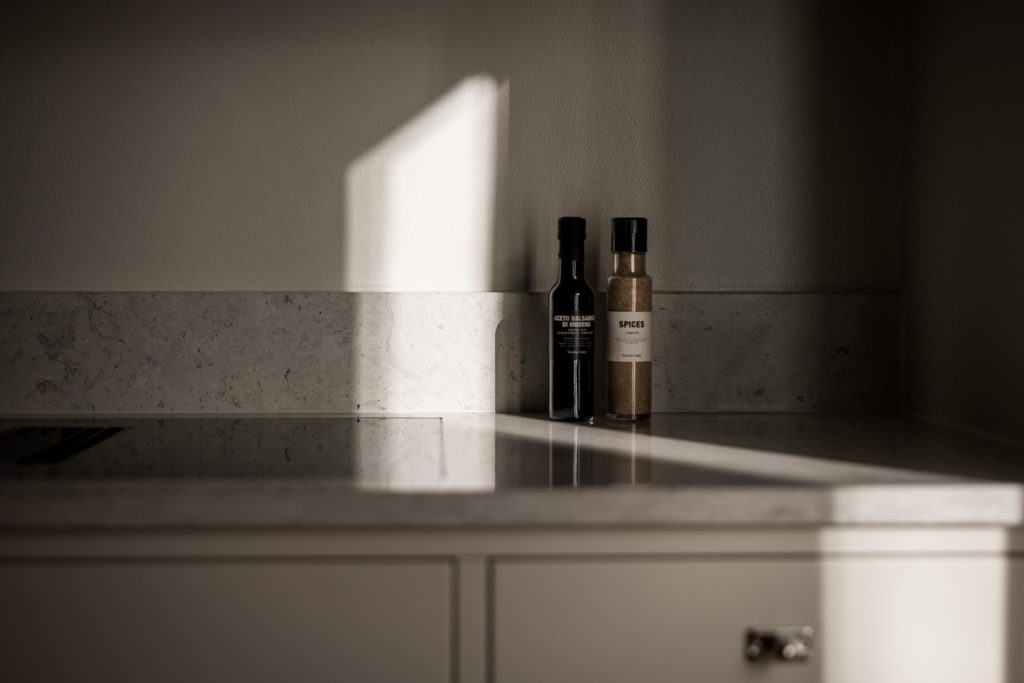
Artificial materials
Laminate and HPL (High Pressure Laminate) worktop
Laminate worktops are a popular solution often used to create stylish but budget-friendly kitchens. These surfaces can imitate various textures, including wood, stone and concrete. They are resistant to dirt but cannot withstand high temperatures. These worktops usually have a thickness of around 20-30 mm.
Benefits and advantages
- Affordable
- Wide range of designs and textures
- Easy to clean: just wipe with a damp cloth
- Relatively resistant to moisture (within reasonable limits) and dirt
Disadvantages
- Cannot withstand high temperatures
- Less resistant to mechanical damage (scratches, chips)
- Cannot be repaired in case of damage, such as deep scratches or cracks
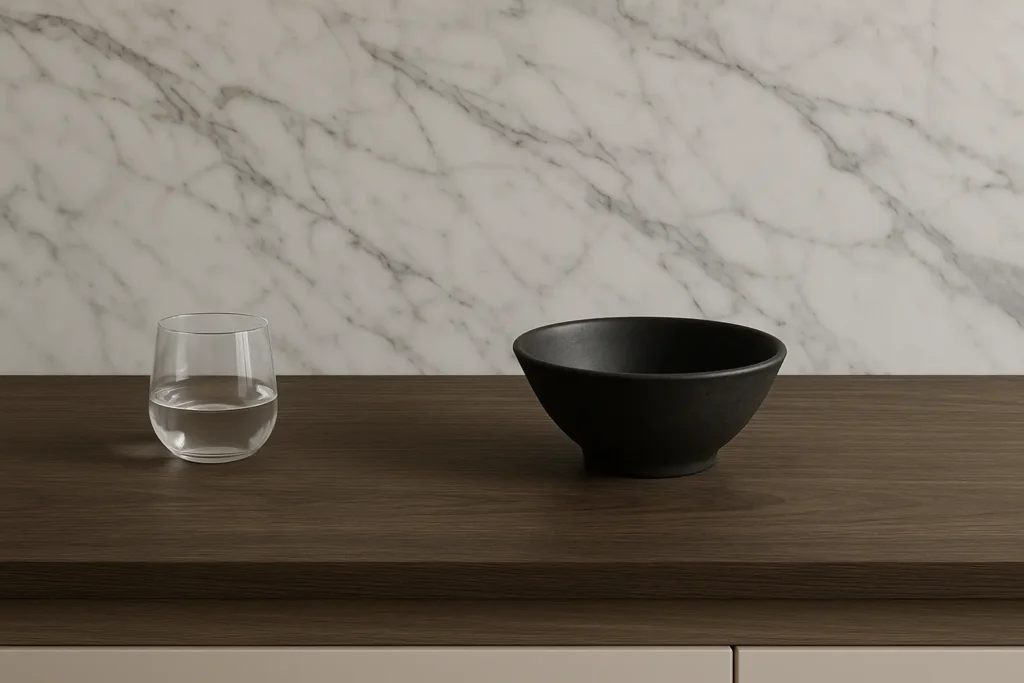
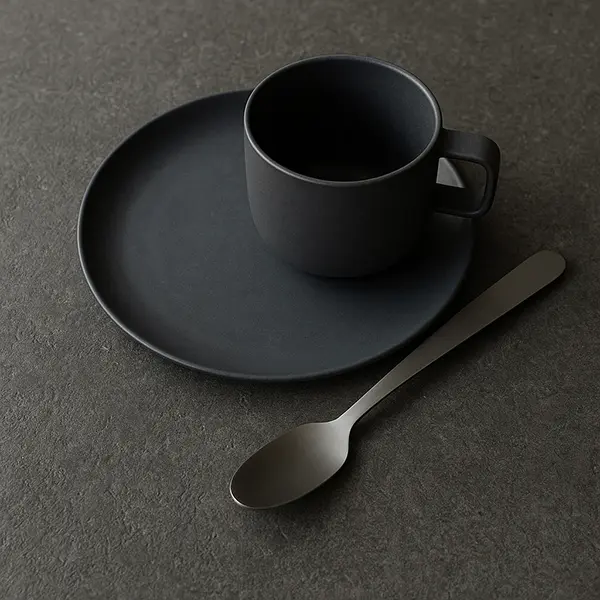
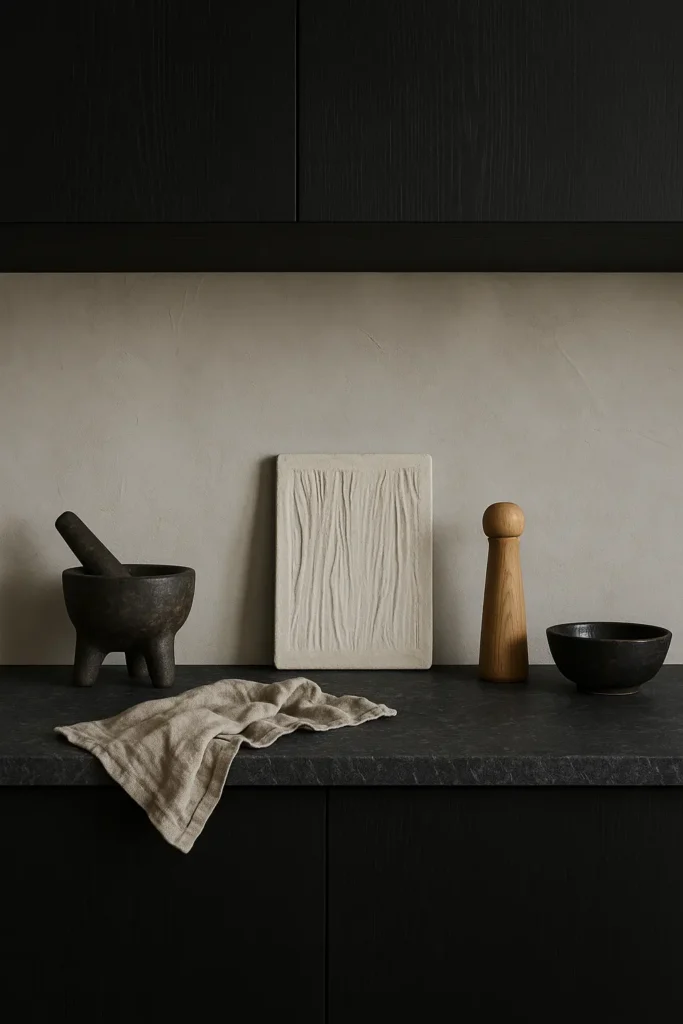
Acrylic worktop
Acrylic worktops are made from acrylic resin with added minerals. They have a smooth, seamless surface that makes them attractive for modern kitchens. These worktops can be easily sanded to restore their appearance in case of scratches. The thickness of acrylic worktops is usually 12, 20, 25 mm.
Acrylic countertops can be integrated with sinks, which retains the seamless design and is great for minimalist interiors.
Benefits and advantages
- Seamlessness and possibility to integrate sinks and other elements
- Repairability – scratches can be sanded or polished
- Hygienic: the material is non-porous, preventing the build-up of dirt and bacteria
- Easy to care for and durable
Disadvantages
- More expensive than laminate
- Less resistant to scratches and high temperatures compared to stone or ceramic
- Can be affected by chemicals and pollution

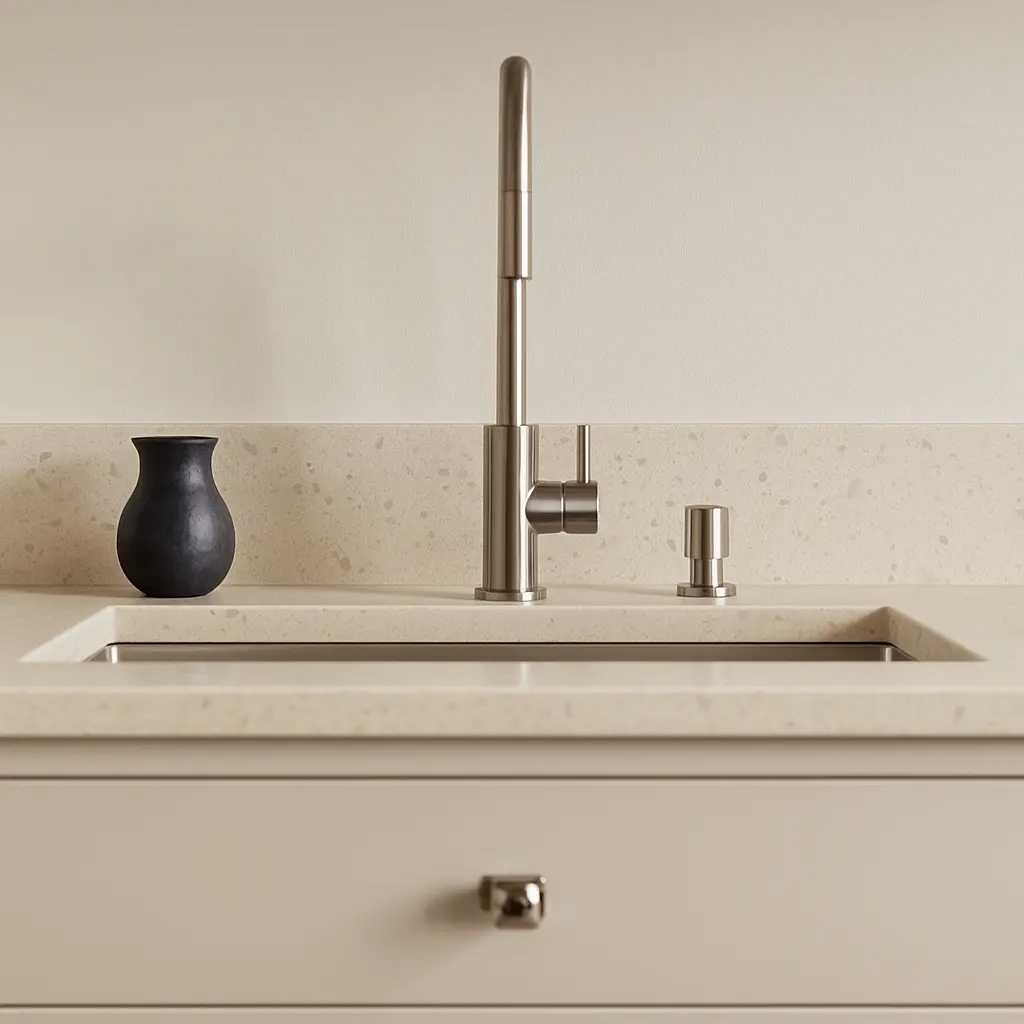
Both options can withstand short-term exposure to cold temperatures, but to protect the surface from possible damage, it is better to use coasters, mats or protective coatings.
Countertops made of artificial materials can lose their color over time if exposed to UV rays and chemicals. Although acrylic is not as prone to fading as laminate, UV rays can still affect its appearance, especially on light or dark shades. With proper care, this is not affected during its normal lifespan.
Care advice
- Regular cleaning and protection against chemicals: Clean the worktop with a mild detergent and water, avoid abrasive cleaners
- Protection against high temperatures: use coasters and mats for hot objects
- Protection against UV rays: Limit direct sunlight, use protective coatings with UV filters for acrylic and laminates
- Protection against mechanical damage: use cutting boards and coasters to prevent scratches
- Preventive treatment: Regularly check the joints and use protective agents to prolong their life.
Worktops made of natural materials
Granite worktop
Granite is one of the most popular and durable natural stones for countertops. It is composed of crystals of quartz, feldspar and other minerals, giving it excellent hardness and resistance to mechanical damage.
Benefits and advantages
- Very durable and long-lasting material
- Highly heat resistant – you can place hot pots directly on the worktop
- Low maintenance: it is enough to clean the surface regularly and seal it if necessary
- Wide range of colors and textures – from black and gray to red and green, with veins, inclusions and patterns
Disadvantages
- Higher price
- Heavy material that requires a stable base
- May be susceptible to microcracking if not properly processed
- Sensitive to acids – lemon, vinegar can leave stains on prolonged contact


Marble worktop
Marble is an elegant and beautiful stone, known for its unique patterns and shades. It is ideal for classic and luxurious interiors.
Benefits and advantages
- Sophisticated look
- Variety of colors and patterns
- Heat resistant
- Marble is a good choice for pastry chefs or those who like to work with dough, as it has the property of cooling products
Disadvantages
- Marble is more porous than granite, which requires regular maintenance and sealing
- Easy to scratch, especially in areas of intensive use
- May react to acids, making it sensitive to products such as lemon juice or vinegar
- Marble is porous, so it can absorb liquid, leading to stains, especially from oil and wine
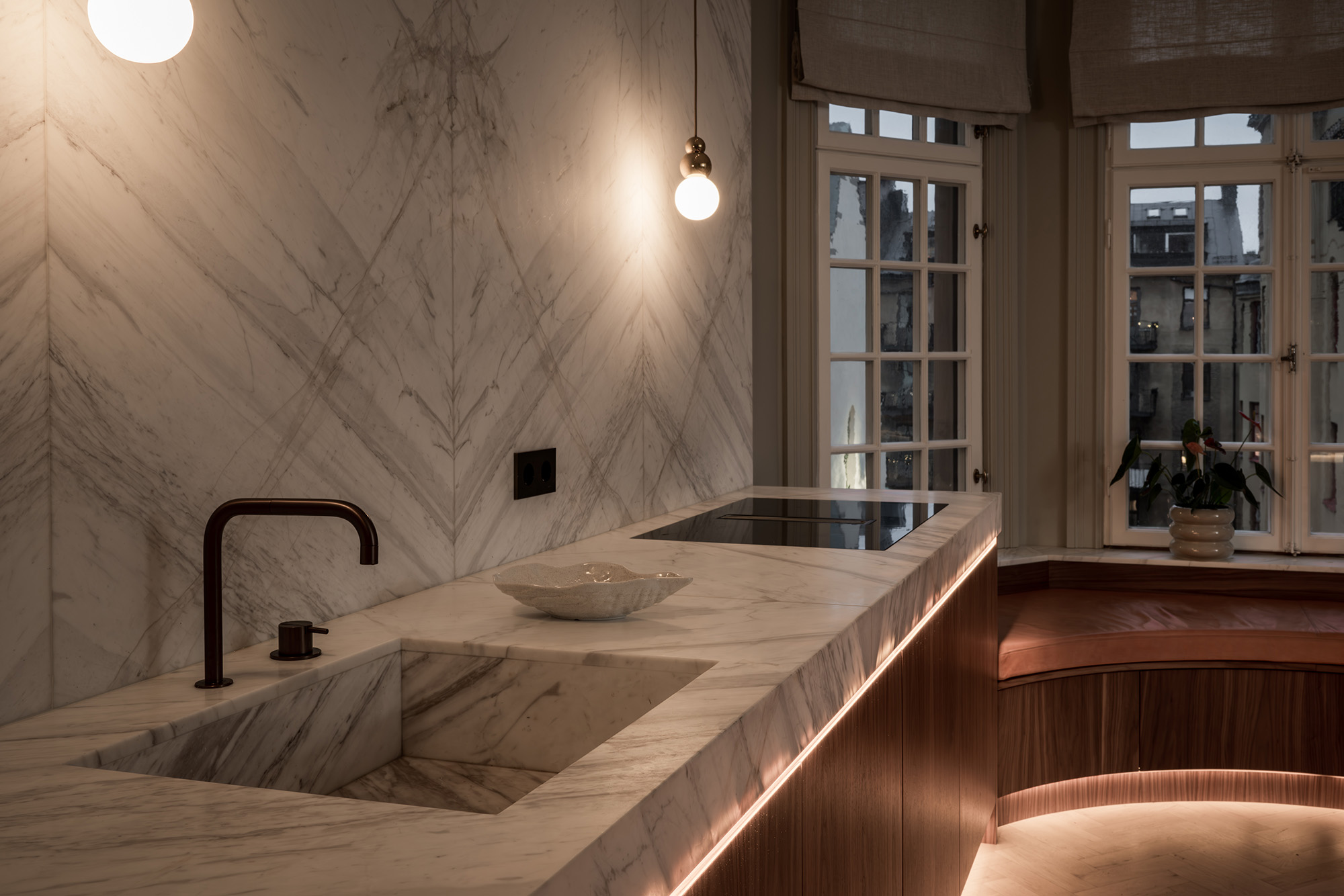


Quartzite worktop
Quartzite is a natural stone that in durability and resistance to scratches and damage is similar to granite, but looks like marble. One of the most popular examples of quartzite is the Taj Mahal stone.
Benefits and advantages
- High resistance to mechanical damage and chemicals
- Beautiful, natural look with textures similar to marble
- Heat resistant
Disadvantages
- Like granite, quartzite is quite heavy and has a higher price
- May require more careful sealing to avoid liquid absorption


Travertine worktop
Travertine has a unique texture with natural cavities and porous areas, making this type of stone excellent for creating rustic and Mediterranean-inspired interiors.
Benefits and advantages
- Unique texture and aesthetics
- Easy to machine, allowing the creation of different shapes and finishes
Disadvantages
- -The porosity of the material makes it more vulnerable to dirt and damage from liquids
- Requires regular sealing
- Less resistant to scratches and impacts compared to granite and quartzite

Onyx worktop
Onyx is a stone with a stunning visual effect, consisting mainly of calcite. It is distinguished from other natural stones by its transparency and clearly marked layers, reminiscent of marble but with even more expressive and dramatic texture.
Benefits and advantages
- Thanks to its transparency, onyx can be illuminated from below, creating an incredibly beautiful and cozy atmosphere. This is often used on bar counters or kitchen islands
- Onyx is softer and lighter than granite or quartzite, making it more malleable when cutting, drilling and installing. This is important when creating non-standard shapes and design solutions
- The onyx surface can be sanded and polished if scratches or wear occur over time.
Disadvantages
- Higher price
- Fragility: Onyx is quite fragile and can be easily damaged
- Onyx can be susceptible to scratches and damage if used incorrectly

Slate worktop
Slate is a metamorphic rock formed from clay and volcanic ash. It is dense, durable, with a natural texture and a matte, slightly grooved surface. Its natural texture, matte finish and deep, dark colors make it particularly suitable in modern minimalist interiors as well as in industrial style and Japanese Wabi-sabi.
Benefits and advantages
- Durability: Slate is resistant to impacts, scratches and wear. It is also widely used in laboratories – it is that durable
- Does not crumble or crack with temperature changes
- Does not deform with heat and does not fade
- Slate is a dense and slightly porous stone. Moisture, grease and dirt penetrate it much more slowly than in marble or travertine
- More affordable than granite or marble
- Does not require frequent sealing (depending on the variety), easy to clean with mild agents, resistant to acids and alkalis in reasonable quantities
Disadvantages
- Limited color range. Mainly dark shades: graphite, dark green, brown, gray
- Difficult to work: Slate is quite difficult to process and may require more specialized installation

Care advice for natural stone worktops
Natural stone requires careful care to maintain its beautiful appearance and functionality for many years:
- Clean the surface regularly with mild detergent and water – avoid harsh chemicals
- Use special protective treatments to prevent liquids from being absorbed and stains from forming
- Carry out impregnation if necessary, especially on porous stones such as marble, travertine and onyx
- Avoid prolonged contact with acids (e.g. lemon juice, vinegar), especially on marble and other sensitive materials
Natural wood worktops
Solid wood
The worktop is made entirely from whole wooden elements that are glued together. This is the most “real” wooden worktop.
Benefits and advantages
- Natural and high aesthetics
- Long shelf life with proper care
- Possibility of multiple grinding and restoration
Disadvantages
- Higher price
- May deform over time with changes in humidity
Glue joint
Consists of small pieces of the same wood species joined together with a “finger” pin and glued into a uniform panel.
Benefits and advantages
- More stable geometry
- Usually lower price than solid wood
- Looks natural
Disadvantages
- Visible joint structure (can be an advantage for those who like industrial style)
- Slightly less durable than solid wood
Oak worktop
Oak is one of the most popular wood species for worktops thanks to its durability and longevity. It has a clear structure and beautiful grain with characteristic annual rings.
Benefits and advantages
- Highly resistant to mechanical damage
- Withstands moisture well, especially if the worktop is treated with protective oils
- Long life: can last for decades
Disadvantages
- Can be heavy, making installation and transportation a bit more complicated
- Requires regular maintenance to preserve the color

Walnut worktop
Walnut is a dark wood with a beautiful, deep shade, dense grain and soft lines.
Benefits and advantages
- Very strong and resistant to mechanical damage
- Retains its shape and appearance well over time
Disadvantages
- High cost, as walnut is considered an expensive wood
- May be more prone to scratches if not properly treated

Beech worktop
Beech is a lighter wood with soft and even grain. Very dense and durable
Benefits and advantages
- Holds its shape well and rarely deforms
- More affordable than oak and walnut
- Easy to process and grind
Disadvantages
- May be less resistant to moisture if not properly treated
- Prone to mechanical damage (scratches, dents)

Teak worktop
Teak is a very dense wood that is ideal for use in high humidity environments. Teak has a golden to brown color and characteristic oily properties.
Benefits and advantages
- Highly resistant to water and external influences
- Long life span
Disadvantages
- High cost and requires more maintenance

Maple worktop
Maple is a light-colored wood that often has characteristic stains and stripes. It has an even grain and good strength.
Benefits and advantages
- Durable and resistant to damage
- Ideal for creating countertops with minimal visible joints and cracks
- More affordable than oak and walnut
Disadvantages
- Despite its durability, maple tends to absorb moisture quickly and can be prone to deformation, especially in high humidity

Ash worktop
Ash is a wood with a clear grain and light shade, close to oak. It is softer than oak but still strong enough.
Benefits and advantages
- Holds its shape well and does not deform
- Fits well in modern interiors and is often used in minimalist styles
- Affordable and easy to process
Disadvantages
- Less resistant to moisture and dirt than oak and walnut

Pine worktop
Pine is a softer wood with light shades and clear growth rings.
Benefits and advantages
- Very good value for money
- Easy to machine and grind, especially if you need flexible shapes
- Fits well in “rural” or “country” style
Disadvantages
- Pine is soft and prone to scratches and dents, which makes it less durable for kitchen worktops that frequently handle sharp objects and hot surfaces. Therefore, it is not recommended for kitchens with high daily traffic
How to choose the right wood for your worktop
- Demanding durability: If the worktop will be exposed to a lot of mechanical damage (e.g. in the kitchen), we recommend stronger wood species such as oak, walnut or teak.
- Aesthetics: For stylish and luxurious interiors, walnut and teak are suitable. For lighter and more cozy interiors, maple and ash are suitable.
- Moisture resistance: If the worktop will be exposed to a lot of moisture, we recommend teak or oak.
- Budget: If you’re on a tight budget, beech or pine is a good choice
Care instructions for natural wood worktops
The care of wooden worktops is important to maintain their beauty and durability for many years.
- Clean the surface regularly with a soft cloth, water and mild detergent – avoid strong chemicals that can damage the wood
- Apply oil or wax at regular intervals to protect against moisture and dirt, especially on high traffic surfaces
- Always use a chopping board when cooking and a trivet for hot objects to avoid scratches and heat damage
- Gently sand the surface if necessary to remove scratches – finish with a new treatment to restore protection
- Protect the wood from direct sunlight to preserve color and luster over time – use curtains or blinds in bright light
Countertops in modern composite materials
Modern materials such as stainless steel, ceramics, concrete and engineered composites offer innovative solutions to create stylish and durable workspaces.
Technological composites for countertops
Engineered composite materials are man-made surfaces composed of a mixture of natural minerals, resins and/or pigments. They are developed to combine the aesthetic properties of natural materials with improved practical durability. Some of the best known are engineered stone, acrylic-based surfaces (e.g. Corian) and ultra-compact materials (e.g. Dekton, Neolith, Laminam).
Quartz composite worktop
Consists of 90-95% finely ground quartz and 5-10% polymer resin.
Benefits and advantages
- Very hard material with high resistance to scratches, stains and moisture
- Available in a wide range of colors and finishes
- Often mimics natural marble or granite but often has better practical properties
- Does not absorb liquids, withstands acids and is easy to clean
- Available in matte, satin and high gloss finishes
Disadvantages
- Cannot withstand extreme heat directly on the surface – always use coasters
- Can crack under very hard impacts

Acrylic-based surfaces (Corian, HI-MACS, Staron)
Made from a mixture of acrylic resin and minerals, which can be molded into different shapes.
Benefits and advantages
- Seamless assembly
- Possibility of integrated sinks
- Easy to repair and sand
- Can be shaped and bent, allowing for rounded edges and special designs
Disadvantages
- Less resistant to scratches and high temperatures than quartz composite

Ultra-compact surfaces (e.g. Dekton, Neolith, Laminam)
Made by sintering natural minerals (pressing and heating them to very high pressure and temperature). Dekton is one of the most well-known in this category and is made using the Technology of Sinterized Particles (TSP), which simulates nature’s own processes – but in just a few hours.
Benefits and advantages
- Extremely resistant to scratches, stains, heat, UV light, chemicals and moisture
- Suitable for both indoor and outdoor use – including outdoor kitchens
- Very wide range of colors and patterns, from industrial concrete look to marbled surfaces
Disadvantages
- Higher price
- Requires professional processing and assembly

Stainless steel worktops
Stainless steel worktops are a modern and functional choice, often used in professional kitchens, but also popular in homes thanks to their durability and stylish aesthetics
Benefits and advantages
- Hygienic – Stainless steel is a non-porous material where bacteria, mold and dirt do not stick. It is easy to clean and very hygienic when cooking
- Moisture and temperature resistant – Withstands water, steam and high temperatures without damage. You can place hot pots directly on the surface without a trivet
- Highly durable – The steel is very durable and resistant to impact, bending, wear and chemicals
- Modern aesthetic – Gives the kitchen an industrial, minimalist or high-tech feel. Pairs well with wood, concrete and glass
- Seamless design with built-in sink or hob – It is possible to weld the sink or other elements directly to the worktop for a completely seamless surface
Disadvantages
- Scratches – Over time, the surface can become finely scratched and lose its shiny finish. Some people find this adds character, while others prefer a more pristine surface
- Noise level – Stainless steel can be perceived as noisy when handling kitchen utensils or when something is dropped
- Fingerprints and stains – Shiny surfaces are prone to fingerprints, water splashes and grease. Regular cleaning is required
- Cold surface – Like stone, steel can feel cold to the touch, especially during the winter months

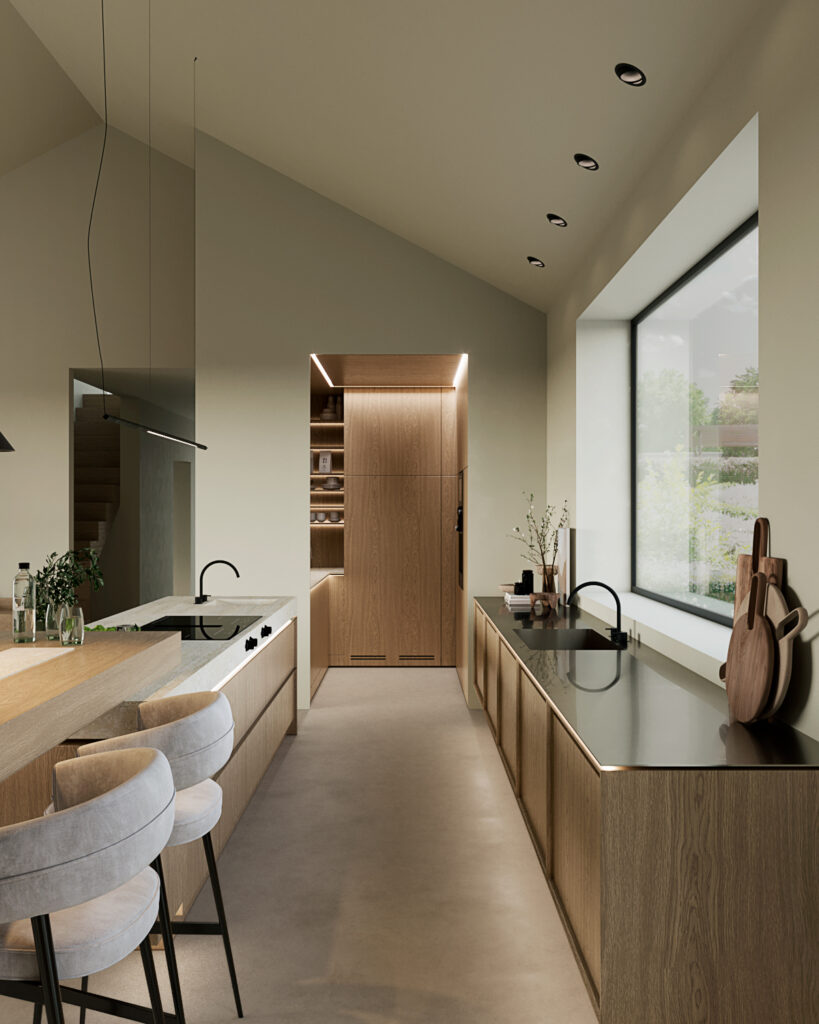
Concrete worktop
A stylish and durable solution for those seeking a unique and industrial look for their kitchen. Concrete is perfect for creating worktops with character, which can become real eye-catchers in the interior.
Benefits and advantages
- Durability and strength: Concrete worktops are extremely durable and resistant to mechanical damage such as scratches and chips. They can withstand high stresses, making them ideal for kitchens with intensive use
- Heat resistance: Concrete resists high temperatures well, making it a good choice for those who often use hot pots and pans
- Surface versatility: The surface of concrete can be treated in different ways, from smooth and matte to rough and textured. You can also use different pigments and add stone, glass or metal inlays
- Ecological: Modern concrete worktops are often made with ecologically clean materials and technologies
Disadvantages
- Susceptibility to moisture: Concrete can absorb water, leading to stains and damage if not properly protected. Therefore, special sealants and coatings need to be used to protect the surface
- Regular care required: To keep concrete worktops in good condition, they must be regularly treated with protective agents to prevent stains and cracks
- Can crack: Despite its durability, concrete can crack, especially if it is not installed correctly or if it is subjected to hard impacts.
- Heavy material: Concrete worktops are quite heavy, requiring a reinforced construction and careful assembly
- High price: Concrete worktops can be more expensive than other materials, due to the manual work required and the weight and installation requirements of the material
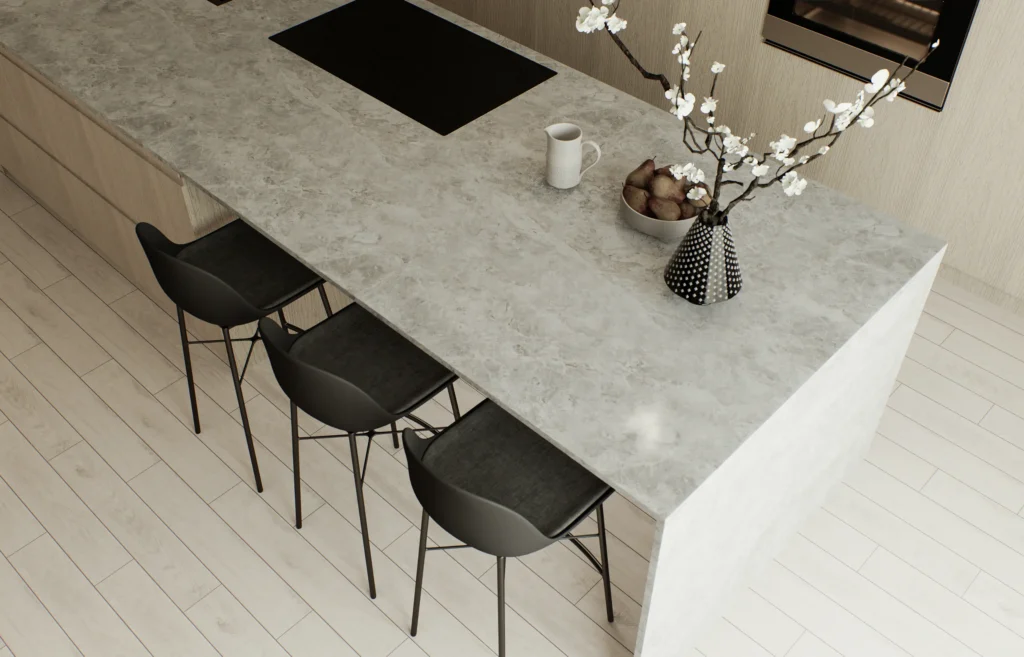
More Guides
Get tips and inspiration for your kitchen journey!

Discover how to choose the right color for your kitchen, tips for kitchen styles, sizes and lighting conditions. Create a kitchen that harmonizes with your whole home.
Read the post: Choosing color in the kitchen
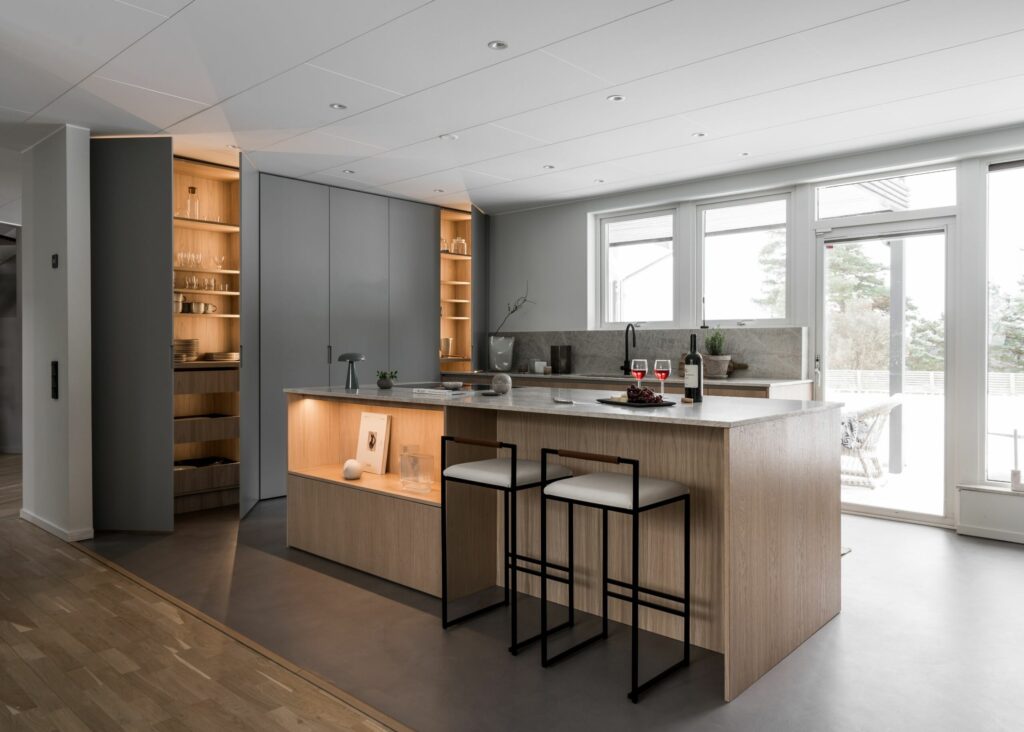
How to choose your kitchen island – a complete guide full of inspiration, tips and ideas. Discover how to plan the right kitchen island for your bespoke kitchen.
Read the post: How to choose a kitchen island
Interested in building a kitchen with Stiligt?
Send us a quote request for your project and our team of experts will guide you through the whole process – from idea to finished project
